Last updated on July 12th, 2024 at 04:21 pm
Introducing our Grey and White Pinwheel Irish Chain Toddler Quilt Pattern! This delightful design features a timeless and charming combination of grey and white hues, creating a soothing and versatile color palette.
The intricate pinwheel and Irish chain patterns add a playful and classic touch, perfect for creating a cozy and stylish nursery or toddler bedroom. This quilt pattern is perfect for quilters of all skill levels, offering a fun and rewarding project to showcase your creativity. Bring a touch of handmade warmth to your little one’s space with this beautiful and engaging quilt pattern.
Give it a Whirl Blog Hop

This quilt is part of the fun quilting March 2024 blog hop over on Just Let Me Quilt. The theme was a project including a “whirl”. This can be a pinwheel, Dresden, or anything that looks like it’s spinning. Make sure to head on over to the blog hop to see all the other designer’s projects.
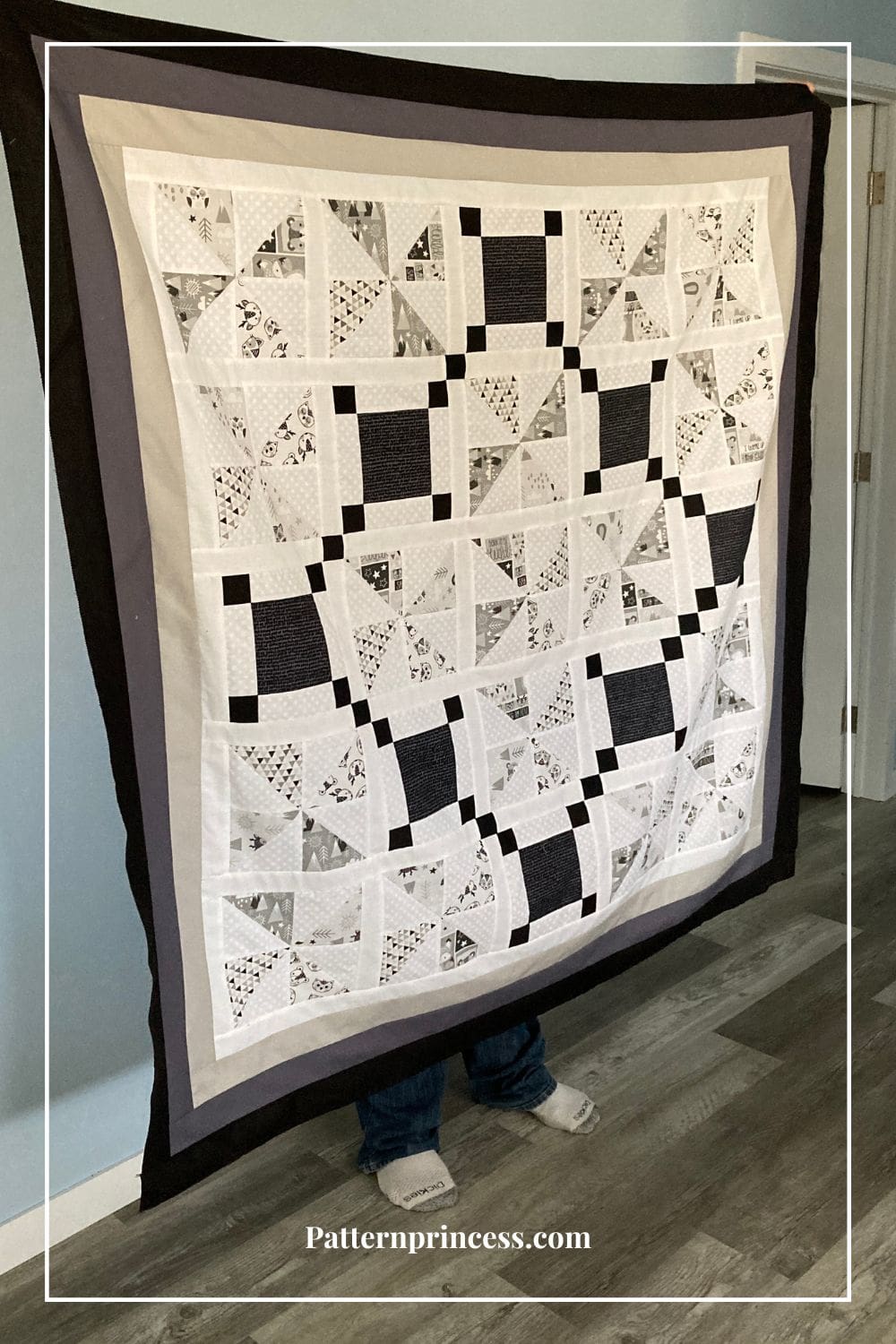
This blanket is also part of the Project Quilting Challenge. The focus of this challenge was Irish Chain quilt blocks. This my entry.
Simple Pattern Featuring Pinwheel and Irish Chain Blocks
Enjoy making this beautiful & easy quilt pattern that features the pinwheel and single Irish chain with a diamond pathway. I just love the connected pathways that Irish Chain Quilts create. They are peaking out between the pinwheels in this blanket pattern.
Shown here in black, grey, and white fabrics. However, this would also be beautiful in darling baby blues, pinks, greens, cheerful fabrics, or any color combination you like. Make one of the larger sizes for a charming farmhouse look or shabby chic quilt. Pretty in pastels, Valentine reds, summertime prints, blues, fall colors, etc.
Just make sure that there is a contrast in the background fabric and the different colors of the pinwheels and Irish Chain squares.

Make Four Different Quilt Sizes
- Crib Quilt /Baby Quilt 51” X 51” and uses 6-inch blocks.
- Toddler Throw Size Quilt 61” X 61” and uses 8-inch blocks.
- Twin Bed Quilt 71” X 71” and uses 10-inch blocks.
- Queen Quilt 81” X 81” and uses 12-inch blocks.
Fat quarter and Jelly Roll Strip Friendly Pattern
I made the toddler throw quilt top using 2 yards of white fabric along with fat quarters and jelly roll strips. Perfect for fat quarters or scraps. Beautiful for summer, winter and all year long.
Small quilts also make a pretty wall hanging. Just sew a hanging sleeve onto the back for easy displaying.
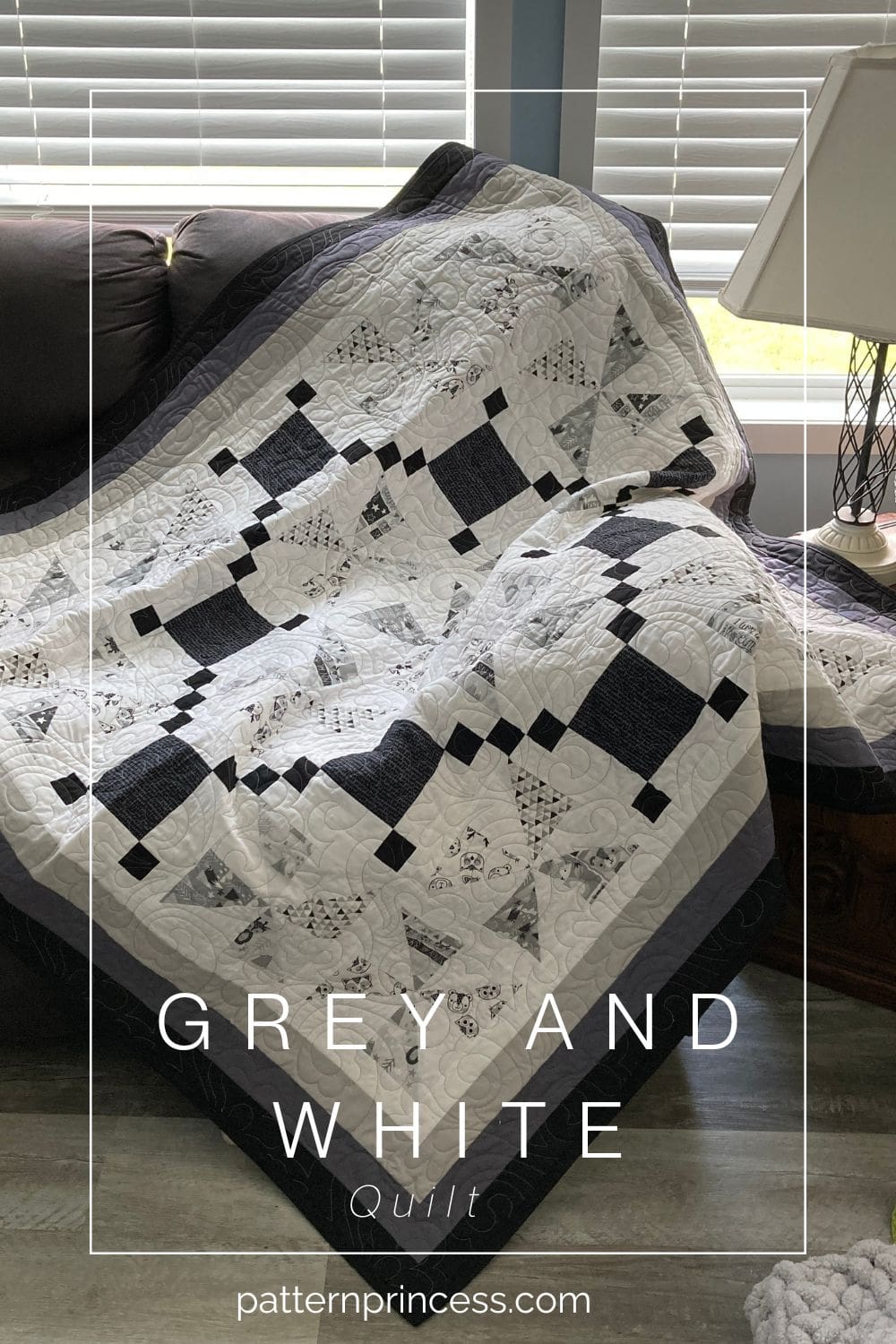
Get your Ad Free Printable PDF of this Pattern in our Etsy Shop.
Directions: Grey and White Pinwheel Irish Chain Toddler Quilt Pattern
Quilting Skill Level
Easy – Confident Beginner
Finished Quilt Measurements
- Crib Throw 51” X 51” and uses 6-inch blocks.
- Toddler Throw 61” X 61” and uses 8-inch blocks. (Pictured)
- Twin 71” X 71” and uses 10-inch blocks.
- Queen 81” X 81” and uses 12-inch blocks.
Fabric Requirements
White Fabric
Crib Throw 1 ¾ yards, Toddler Throw 2 yards, Twin 2 yards, and Queen 3 yards.
Black and White, Cute Animals and Trees fabric for the toddler throw shown is from the fat quarter bundles at Joann Fabrics.
Crib Throw 1 ¼ yards, Toddler Throw 1 ½ yards, Twin 2 yards, and Queen 2 ½ yards.
Black with Dots
Crib Throw ¼ yard, Toddler Throw 1/4 yards, Twin 3/4 yard, and Queen 1 yard.
Solid Black
Crib Throw 1/8 yard, Toddler Throw 1/8 yard, Twin ½ yard, and Queen ¾ yard.
Jelly Roll in Ash
Crib Throw ¾ yard pieced or 5 strips pieced, Toddler Throw ¾ yard pieced or 5 strips pieced, Twin 1 yard pieced or 8 strips pieced, and Queen 1 ¼ yards pieced or 9 strips pieced.
Jelly Roll in Coal
Crib Throw ¾ yard pieced or 6 strips pieced, Toddler Throw ¾ yard pieced or 6 strips pieced, 1 yard pieced or 8 strips pieced, and Queen 1 ¼ yards pieced or 9 strips pieced.
Jelly Roll in Black
Crib Throw ¾ yard pieced or 6 strips pieced, Toddler Throw ¾ yard pieced or 6 strips pieced, Twin 1 yard pieced or 8 strips pieced, and Queen 1 ¼ yards pieced or 9 strips pieced.
Backing Fabric
- Crib Throw 55″ X 55″ 1 1/4 yards of 108″ fabric 2 yards of 44″ width pieced.
- Toddler Throw 65″ X 65″ 2 yards of 108″ or 4 yards of 44″ width pieced.
- Twin 75″ X 75″ 2 1/4 yards of 108″ or 4 1/2 yards of 44″ width pieced.
- Queen 85″ X 85″ 2 1/2 yards of 108″ or 4 3/4 yards of 44″ width pieced.
Batting
- Crib Throw 55″ X 55″
- Toddler Throw 65″ X 65″
- Twin 75″ X 75″
- Queen 85″ X 85″
Binding
- Crib Throw 3/4 yard,220″ X 2 1/2″, 6 strips pieced.
- Toddler Throw 3/4 yard, 260″ X 2 1/2″, 6 strips pieced.
- Twin 1 yard, 300″ X 2 1/2″, 8 strips pieced.
- Queen 1 1/4 yards, 330″ X 2 1/2″, 9 strips pieced.

Materials and Equipment/Tools
All the quilts will use the following materials and tools to complete.
- Thread
- Rotary Cutter
- Quilting Ruler
- Cutting Mat
- Rotating Cutting Mat
- Iron
- Ironing Board or Pressing Mat
- Pins
- Clips
- Sewing Machine

General Cutting and Sewing
The directions for this quilt are for rotary cutting, machine piecing, machine quilting, and the binding is hand-stitched to the quilt back.
Accurate cutting and sewing helps ensure that seams line up for a beautiful quilt top. Pin your pieces together before sewing them to ensure proper seam alignment.
All sewing in this tutorial uses ¼” seam allowance.
All fabric is sewn right sides together unless otherwise noted.
Pattern Notes
The quilt shown is the Toddler Throw Quilt 61 X 61 inches, shown. Uses 8-inch finished blocks.
Choose any contrasting or complimenting colors of fabric.
There are both colored photos and charts to help with the construction of the blanket.
You can use the strip piecing method. When you want to make a lot of blocks, this method will save you a ton of time.
WOF = Width of Fabric
HST = Half Square Triangles
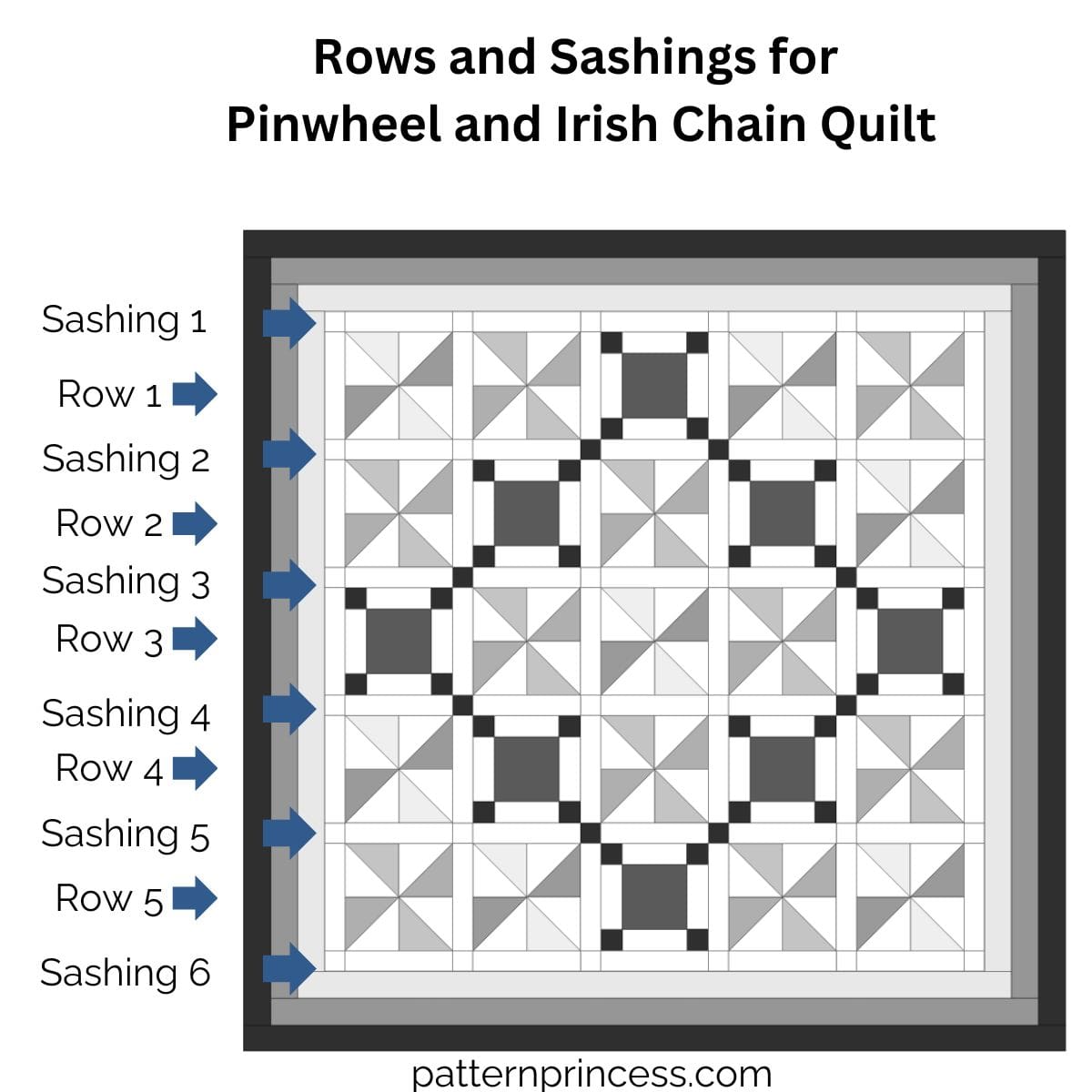
Quilt Top Sewing Directions
Begin by Sewing the Irish Chain Quilt Blocks
The four sizes of quilts for this pattern use the following block sizes.
Make 8
Use white fabric, black with dots, and the solid black fabric for this block.
You may want to reference the blog post on How to Make a Single Irish Chain Quilt Block Pattern if this is new to you.
Finished Sizes
- 6” X 6”
- 8” X 8”
- 10” X 10”
- 12” X 12”
Remember, unfinished sizes you need to add ½ inch to all four sides.
Cutting Charts for Making Multiple Blocks out of fabric strips.
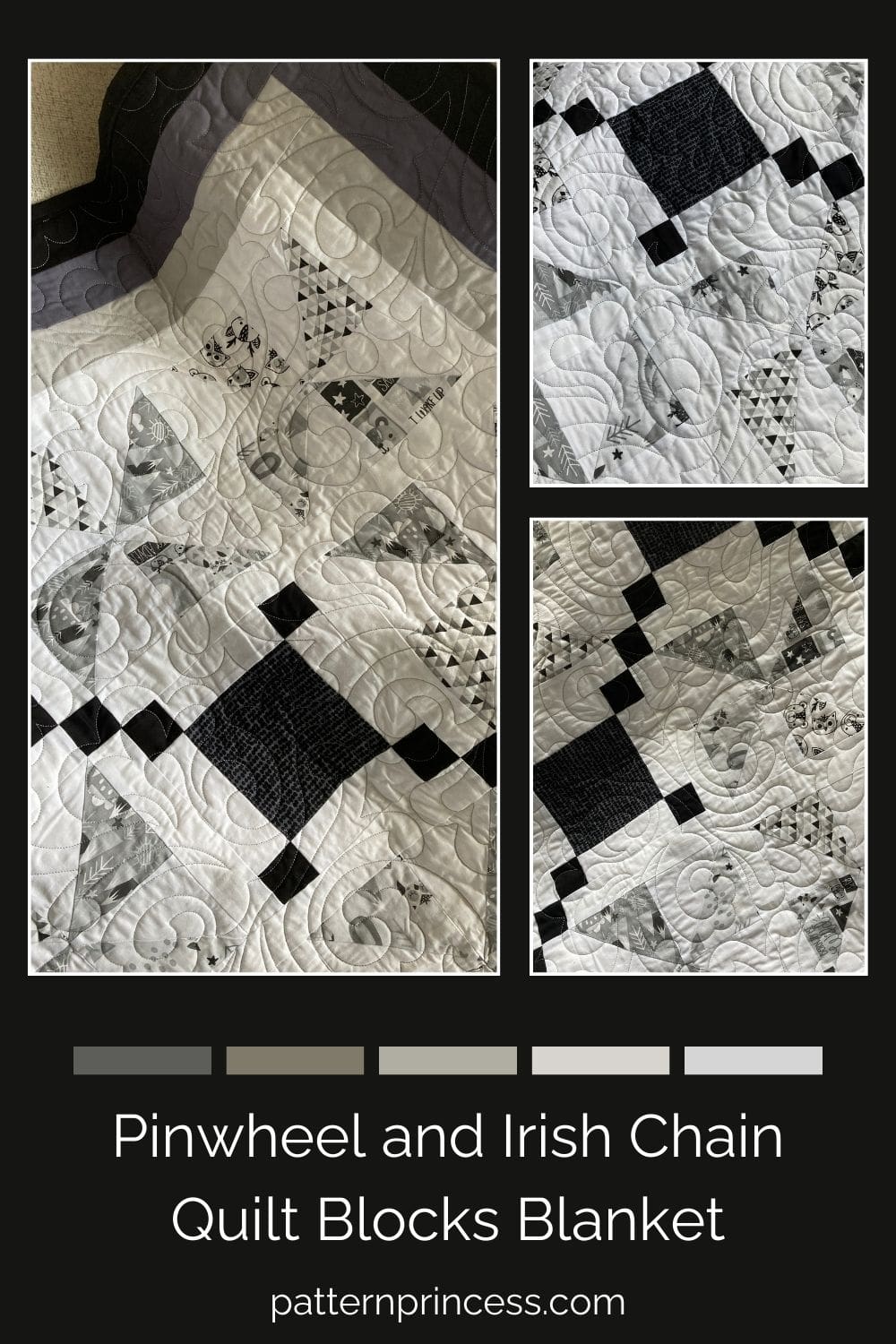
Four Different Sizes
6″ x 6″ Finished Blocks
Strip Set A:
- Dark: two 1 11/16″ x WOF strips
- Light: one 4 1/8″ x WOF strip
Strip Set B:
- Dark: one 4 1/8″ x WOF strip
- Light: two 1 11/16″ x WOF strips
8″ x 8″ Finished Blocks
Strip Set A:
- Dark: two 2 1/8″ x WOF strips
- Light: one 5 5/16″ x WOF strip
Strip Set B:
- Dark: one 5 5/16″ x WOF strip
- Light: two 2 1/8″ x WOF strips
10″ x 10″ Finished Blocks
Strip Set A:
- Dark: two 2 1/2″ x WOF strips
- Light: one 6 1/2″ x WOF strip
Strip Set B:
- Dark: one 6 1/2″ x WOF strip
- Light: two 2 1/2″ x WOF strips
12″ x 12″ Finished Blocks
Strip Set A:
- Dark: two 2 7/8” x WOF strips
- Light: one 7 11/16″ x WOF strip
Strip Set B:
- Dark: one 7 11/16″ x WOF strip
- Light: two 2 7/8” x WOF strips
Make the Strip

Make the Strip Sets for the Single Irish Chain
Strip Set A
With the right sides together, sew the darker fabric “A” strip lengthwise to the wider lighter fabric “A” strip. Repeat this process and add the second darker fabric strip on the other side.
Press the seams to the outside towards the dark strips.
Using a quilting ruler and rotary cutter, square up one end of the long strip. Then cut into segments using the following measurements, as shown in the diagram.
- 1 11/16″ long for the 6” block.
- 2 1/8″ long for the 8” block.
- 2 1/2″ long for the 10” block.
- 2 7/8” long for the 12” block.
Strip Set B
With the right sides together, sew the lighter fabric “B” strip lengthwise to the wider darker fabric “B” strip. Repeat this process and add the second lighter fabric strip on the other side.
Press the seams to the inside towards the dark strips.
Using a quilting ruler and rotary cutter, square up one end of the long strip. Then cut into segments using the following measurements, as shown in the diagram.
- 4 1/8″ long for the 6” block.
- 5 5/16″ long for the 8” block.
- 6 1/2″ long for the 10” block.
- 7 11/16″ long for the 12” block.
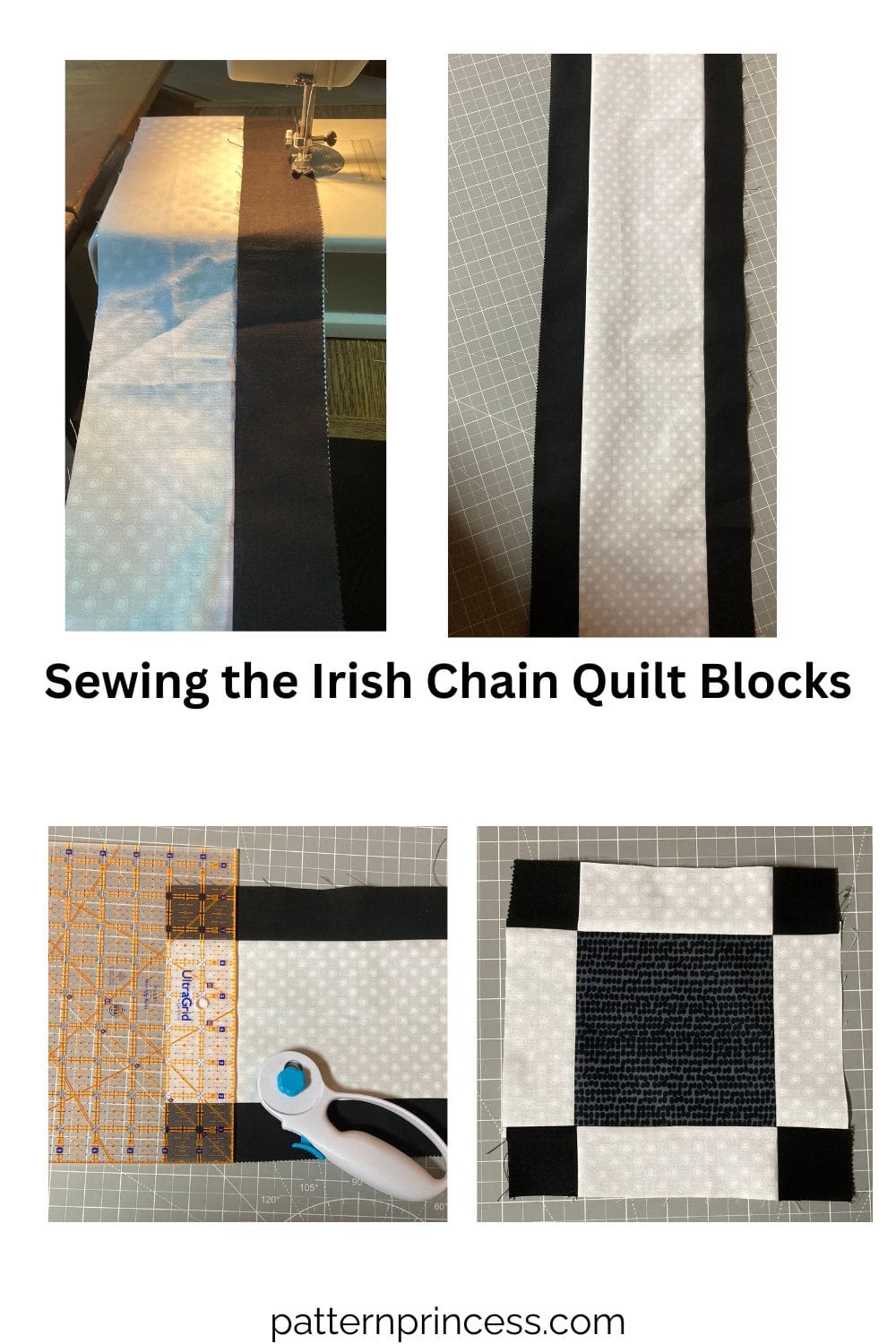
Assembling and Sewing the Single Irish Chain Quilt Block
With the right sides together and using ¼” inch seam allowance, sew an “A” section onto the top of a “B” section. Make sure to nest seams. Press the seam allowance toward the “B” section.
Sew another “A” section onto the bottom of a “B” section. Nesting the seams and using ¼ inch seam allowance. Press the seams towards the “B” section.
Trim the quilt block ½” inch taller and wider than the desired finished size.
Continue repeating this process until all 8 blocks are sewn together.
Set them aside.
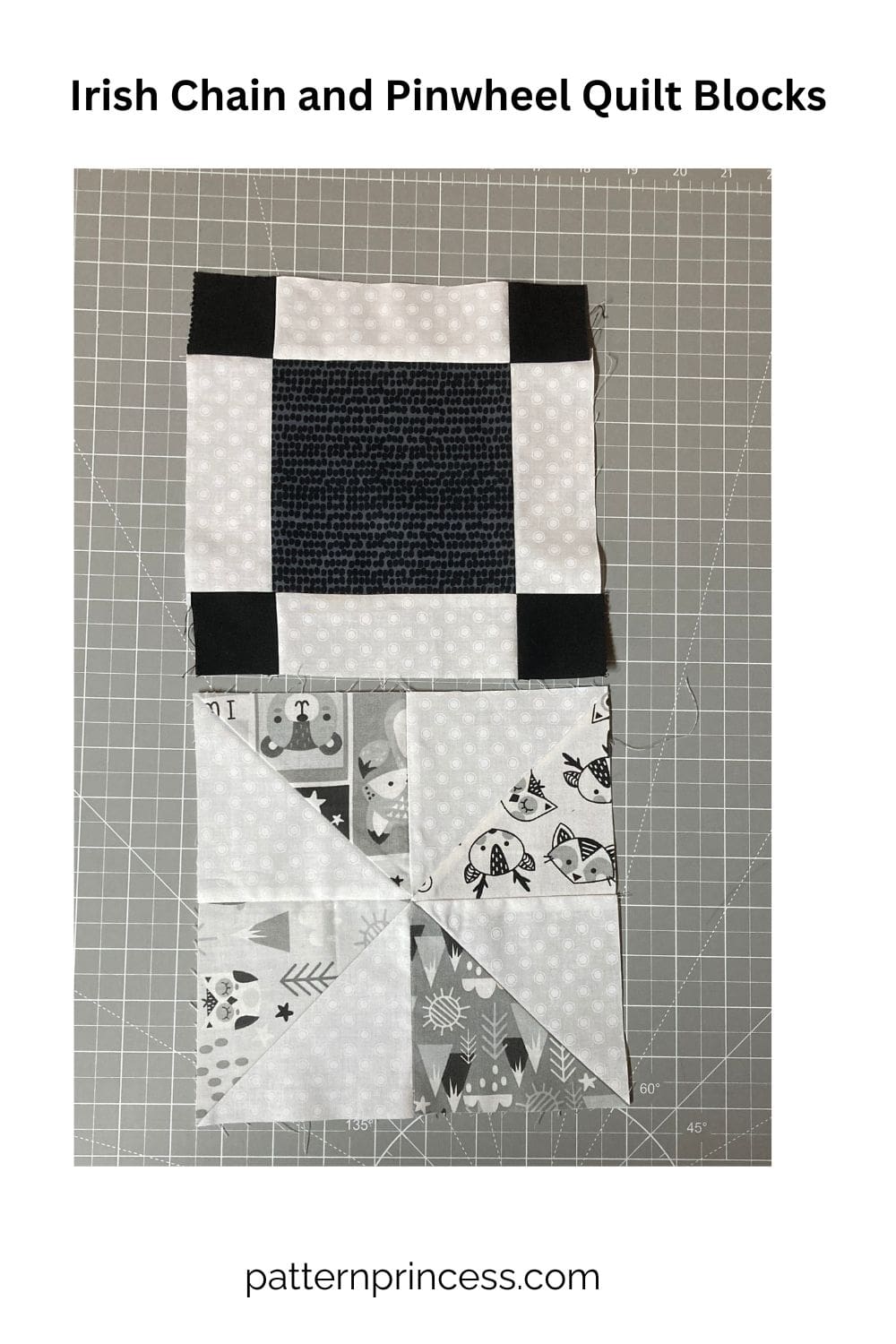
Sew the Pinwheel Quilt Blocks
For this block use white, black and white fabric.
If this is your first time making a pinwheel quilt block, you may want to refer to our blog post on How to Make a Pinwheel Quilt Block.
Finished Sizes
- 6” X 6”
- 8” X 8”
- 10” X 10”
- 12” X 12”
Each half square triangle is made using two colors of fabric squares. You will need 4 half square triangles. Every two squares make two finished HST units. Each Pinwheel quilt block is made up of 4 half square triangles.
Here is a tutorial for the half square triangles.
Instructions
Cut fabric the Squares.
- 34 black and white
- 34 white
- You will be making 17 Pinwheel quilt blocks using the squares.
- Refer to the sizes below.
Note: I like to make my half square triangles larger than needed. It gives me enough fabric to square them up nicely after they are sewn together and cut apart.
- 6” X 6” finished size, 6 ½” X 6 ½” unfinished. Start with 7 ½” X 7 ½” squares.
- 8” X 8” finished size, 8 ½” X 8 ½” unfinished. Start with 9 ½” X 9 ½” squares.
- 10” X 10” finished size, 10 ½” X 10 ½” unfinished. Start with 11 ½” X 11 ½” squares.
- 12” X 12” finished size, 12 ½” X 12 ½” unfinished. Start with 13 ½” X 13 ½” squares.
Next, Mark the Squares. Starting with equal size squares of fabric, place the ruler diagonally on the back side of the lightest square. Use a pencil to draw a diagonal line from one corner to the opposite corner.
Place the lighter square on top of the darker square with the right sides together matching the edges all the way around. Secure with straight pins.
Sew a scant 1/4-inch seam allowances on each side of the marked line.
Separate Triangles by cutting along the diagonal seams agone the center line using a rotary cutter. You now have two half-square triangles.
Press seams to one side toward the darker fabric or open, trim the square.
Continue repeating this process until all the HST units are sewn and pressed.
Laying out the Classic Pinwheel Quilt Block
Using 4 half square triangles layout in the pinwheel design. Refer to the quilt pattern to make sure that they are pointing in the correct direction.
Pinwheel Block Assembly
With the right sides together, sew together the top two blocks using a quarter inch seam Allowance. Press the seams to the right.
Sew the bottom two blocks together using a quarter inch seam allowance. Press the seams to the left.
Next align the top and bottom block sets so that the middle seam nests together. This allows the points to line up nicely.
Sew the top to the bottom, using a quarter inch seam allowance. Press the seam open.
Next trim your quilt block to the unfinished size.
Here are the measurements again for your reference.
- 6 ½” X 6 ½” unfinished.
- 8 ½” X 8 ½” unfinished.
- 10 ½” X 10 ½” unfinished.
- 12 ½” X 12 ½” unfinished.
Here is a diagram to help visualize the steps in creating an easy pinwheel block.
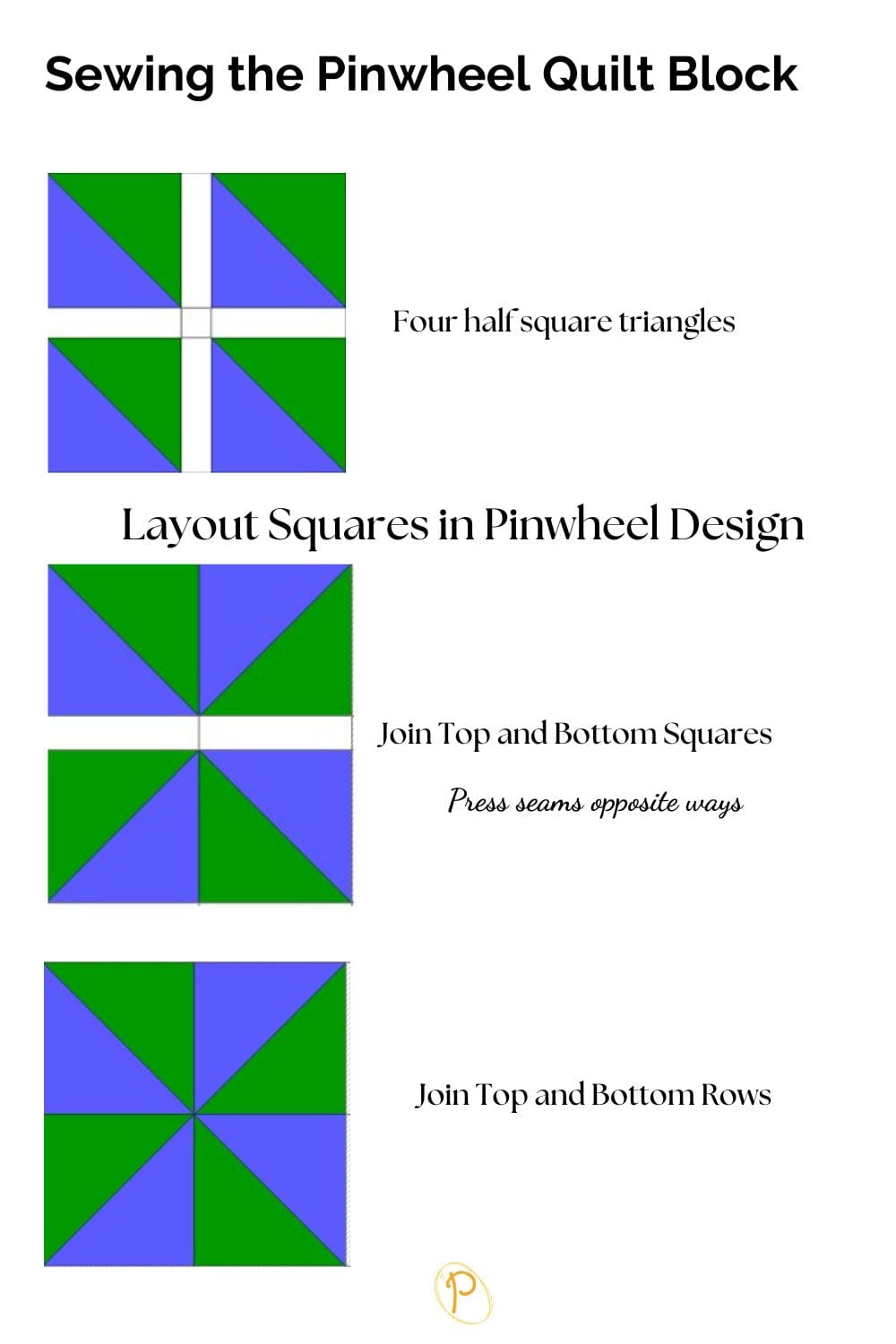
Quilt Top Assembly
Layout the pinwheel and Irish chain blocks according to the diagram of the quilt top.
Sewing on the Sashing Pieces
We will add vertical side sashing pieces to the blocks on the left and right sides. Before we work on the rows.
Using the White Fabric
For each block size, you will cut 30 Rectangles. Refer to the measurements below for your block size.
- 6 ½” X 2”
- 8 ½” X 2”
- 10 ½” X 2”
- 12 ½” X 2”
I cut 2” WOF strips and sub cut them into the lengths needed for the unfinished quilt square size noted above.
Starting in the top left (row 1) with the right sides together, sew a white strip onto the left and right of the first pinwheel block. Pressing seams to the sashing.
Sew the next block in the row, which in this case is another pinwheel block. Then a sashing, then an Irish chain block, sashing, pinwheel, sashing, pinwheel, and end with a sashing on the right side of the last block. Press all seams to the sashing strips.
Continue this process for the next four rows.
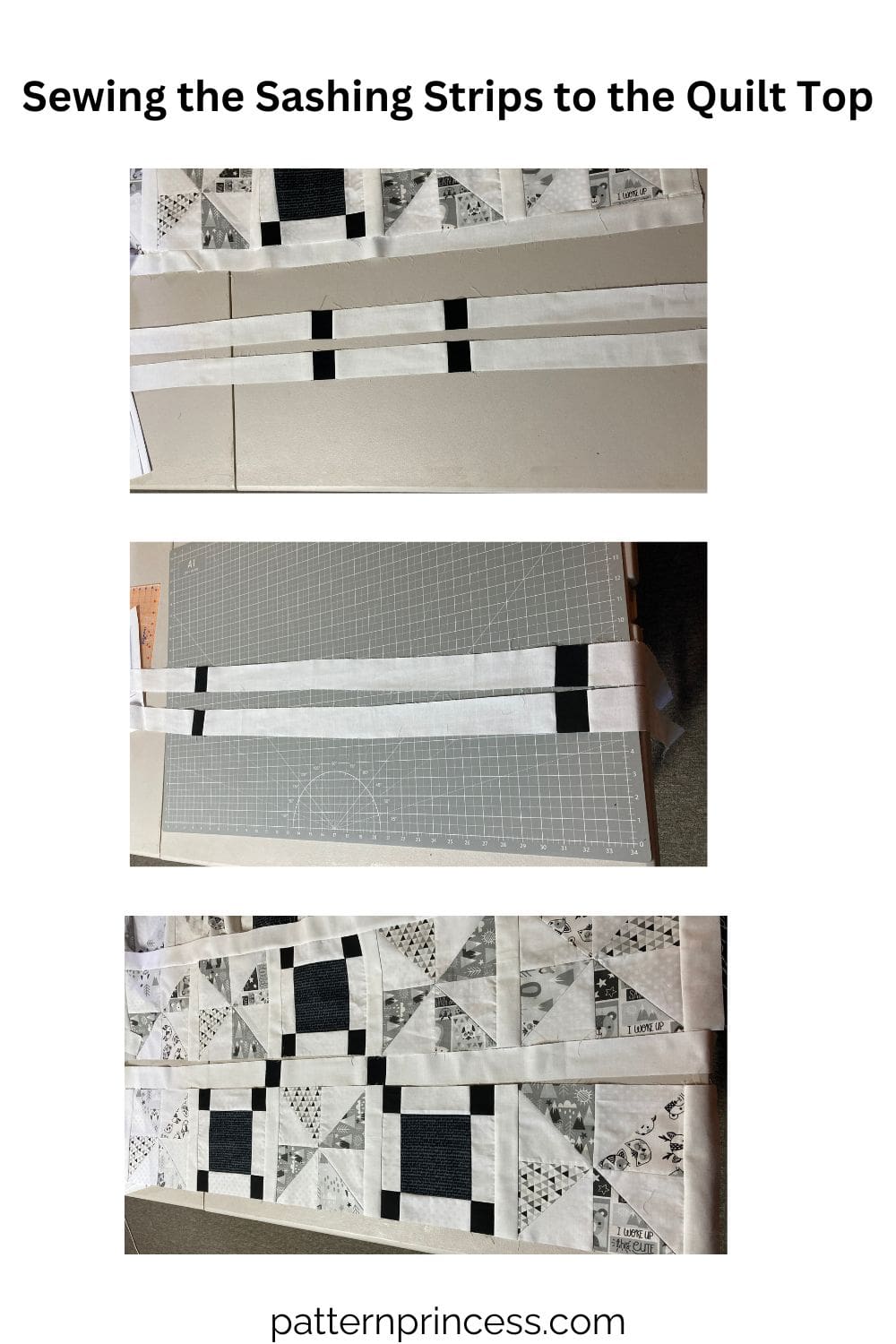
Join the Rows Together
You will be adding horizontal sashing pieces and squares between the rows to join them together.
Use the white fabric and the black fabric for this step.
**Sashing rows 1 and 6 are the same, rows 2 and 5 are the same, and rows 3 and 4 are the same.
Begin with sashing rows 1 and 6, which are the top and bottom white strips.
- Crib Throw, White fabric cut (2) 39 ½ X 2 inches.
- Toddler Throw, White fabric cut (2) 49 ½ X 2 inches.
- Twin, White fabric cut (2) 59 ½ X 2 inches.
- Queen, White fabric cut (2) 69 ½ X 2 inches.
Pin the sashing strip to the top of row 1. With the right sides together using ¼” seam allowance, sew the sashing to the top row. Press the seam to the outside.
Repeat the steps for the bottom of row 6.
Sashing Rows 2 and 5.
- Crib Throw, White fabric cut (2) 6 ½” X 2”, cut (2) 15 ½ X 2 inches, cut (2) 2” X 2” Black squares.
- Toddler Throw, White fabric cut (2) 8 ½” X 2”, cut (2) 19 ½ X 2 inches. cut (2) 2” X 2” Black squares.
- Twin, White fabric cut (2) 10 ½” X 2”, cut (2) 23 ½ X 2 inches, cut (2) 2” X 2” Black squares.
- Queen, White fabric cut (2) 12 ½” X 2”, cut (2) 27 ½ X 2 inches, cut (2) 2” X 2” Black squares.
With right sides together using ¼” seam allowance, sew a black square on the right and left ends of the shorter white strip. Next sew the longer white strip onto the black squares. (1 on each side). Press seams to the white strip.
Repeat this for the other two strips and two black squares.
Pin the sashing strip to the bottom of row 1, aligning the seams. With the right sides together using ¼” seam allowance, sew the sashing to the top row. Press the seam to the outside. Pin the top of row 2 to the bottom of the sashing strip and sew in place.
Repeat the steps sewing the other sashing piece onto the top of row 6 and bottom of row 5.
Press the seams to the sashing strips.
Sashing Rows 3 and 4.
- Crib Throw, White fabric cut (2) 7 ½” X 2”, cut (2) 21 ½ X 2 inches, cut (2) 2” X 2” Black squares.
- Toddler Throw, White fabric cut (2) 9 ½” X 2”, cut (2) 27 ½ X 2 inches. cut (2) 2” X 2” Black squares.
- Twin, White fabric cut (2) 11 ½” X 2”, cut (2) 33 ½ X 2 inches, cut (2) 2” X 2” Black squares.
- Queen, White fabric cut (2) 13 ½” X 2”, cut (2) 39 ½ X 2 inches, cut (2) 2” X 2” Black squares.
With right sides together using ¼” seam allowance, sew a black square on the right and left ends of the longer white strip. Next sew the shorter white strip onto the black squares. (1 on each side). Press seams to the white strip.
Repeat this for the other two strips and two black squares.
Pin the sashing strip to the top of row 3, aligning the seams. With the right sides together using ¼” seam allowance, sew the sashing to the row. Press the seam to the sashing. Pin the bottom of row 2 to the top of the sashing strip and sew in place.
Repeat the steps sewing the other sashing piece onto the bottom of row 3 and top of row 4.
Press the seams to the sashing strips.
The center squares and sashings should all be sewn together at this time.
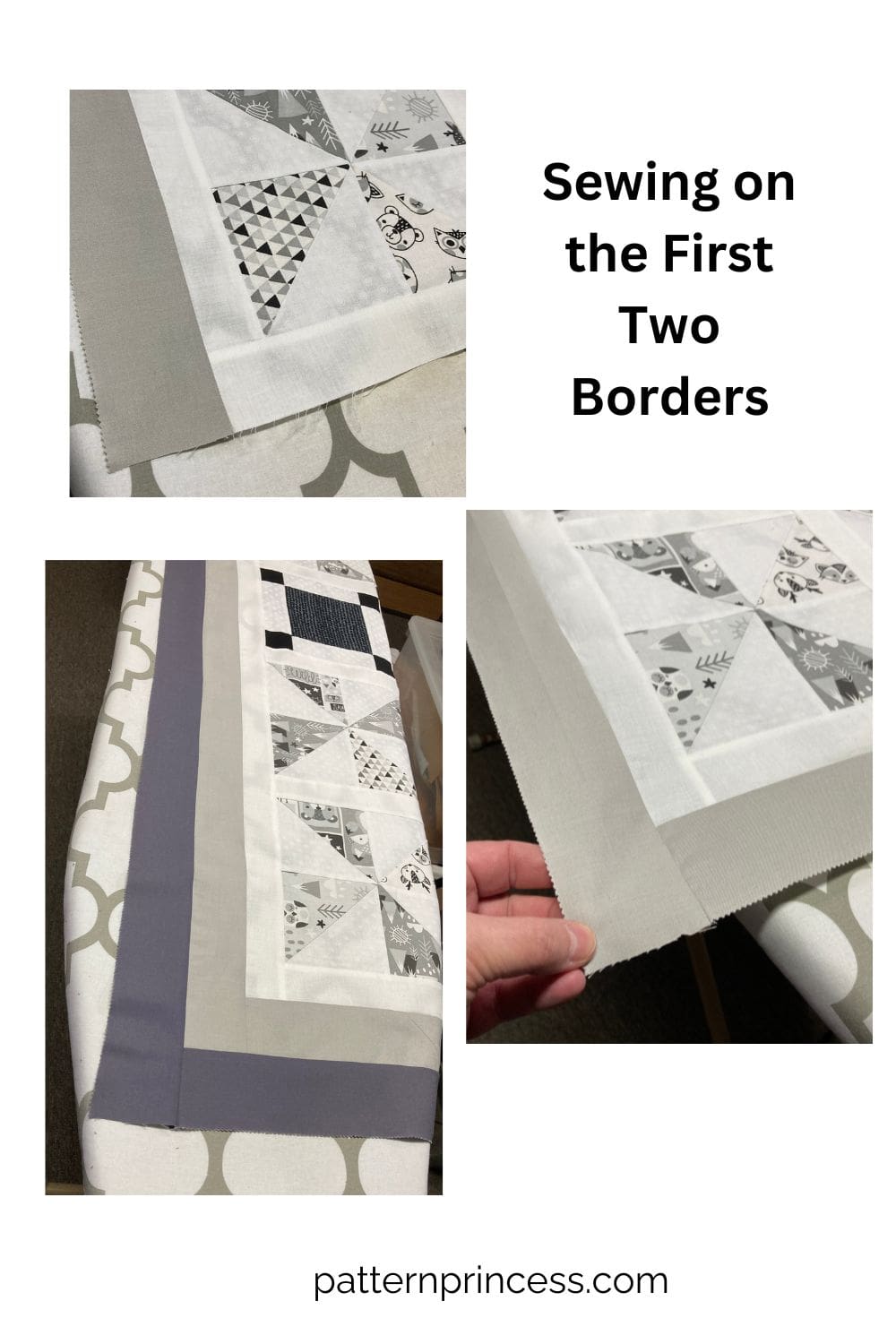
Sewing the Three Borders to the Quilt Top
Border 1
Use the Ash jelly roll strip.
- Crib Throw, cut (2) Sides 39 ½” X 2 ½”, cut (2) Top and bottom 43 ½” X 2 ½”.
- Toddler Throw, cut (2) Sides 49 ½” X 2 ½”, cut (2) Top and bottom 53 ½” X 2 ½”.
- Twin, cut (2) cut (2) Sides 59 ½” X 2 ½”, cut (2) Top and bottom 63 ½” X 2 ½”.
- Queen, cut (2) cut (2) Sides 69 ½” X 2 ½”, cut (2) Top and bottom 73 ½” X 2 ½”.
Border 2
Use the Coal jelly roll strip.
- Crib Throw, cut (2) Sides 43 ½” X 2 ½”, cut (2) Top and bottom 47 ½” X 2 ½”.
- Toddler Throw, cut (2) Sides 53 ½” X 2 ½”, cut (2) Top and bottom 57 ½” X 2 ½”.
- Twin, cut (2) cut (2) Sides 63 ½” X 2 ½”, cut (2) Top and bottom 67 ½” X 2 ½”.
- Queen, cut (2) cut (2) Sides 73 ½” X 2 ½”, cut (2) Top and bottom 77 ½” X 2 ½”.
Border 3
Use the Black jelly roll strip.
- Crib Throw, cut (2) Sides 47 ½” X 2 ½”, cut (2) Top and bottom 51 ½” X 2 ½”.
- Toddler Throw, cut (2) Sides 57 ½” X 2 ½”, cut (2) Top and bottom 61 ½” X 2 ½”.
- Twin, cut (2) cut (2) Sides 67 ½” X 2 ½”, cut (2) Top and bottom 71 ½” X 2 ½”.
- Queen, cut (2) cut (2) Sides 77 ½” X 2 ½”, cut (2) Top and bottom 81 ½” X 2 ½”.
For each border sew the Jelly roll strips together or cut your own 2 ½” WOF strips and join them together. You can find the number of jelly roll strips you need to piece together, or the fabric yardage needed in the fabric requirements chart above.
Begin by sewing on the vertical border pieces on the sides.
Using the 2 vertical pieces of sashing, pin on the sides of the quilt top with the right sides together. Using ¼-inch seam allowance, sew 1 sashing strip to each side of the quilt. Press all seams to the outside or open.
Horizontal border strips on the top and bottom.
Using the 2 horizontal pieces strips, pin on the top and bottom of the quilt top with the right sides together. Using ¼-inch seam allowance, sew 1 strip to each side of the quilt. Press all seams to the outside or open.
Repeat this process for the second and third borders.
Your Quilt top is finished at this point.
Layer the Top, Batting, and Back
Sandwich the quilt backing fabric, batting, and the quilt top.
The backing fabric and the batting should be a few inches larger all the way around than the quilt top. Refer to the fabric, backing, and batting size chart above for each specific quilt size.
This makes sure that there is backing and batting covering the entire quilt top fabric. If you cut it too close and there is any slippage, you might end up with an edge that does not have the bottom part of the quilt sandwich.
Begin by placing the backing fabric on a flat solid surface, right side down facing out. Smooth out any wrinkles. Use painters’ tape to secure the edges of the fabric down. This will help hold it in place and reduce the chance of a wrinkle developing as you place the next two layers.
Next, center the batting on top of the backing fabric smoothing out any wrinkles.
Finally, place the quilt top on the batting, centering it with the right side up. Smooth out any wrinkles.
Baste the Quilt Together and Quilt the Layers Together
Once you have the top fabric all smoothed out, baste all three layers together using large safety pins. Use a good quality 1 ½” stainless steel pin for this.
Put a pin in each corner and around the entire quilt about every 5-6 inches or so through all three layers.
This holds things in place, so they don’t move around while you are sewing the layers together using a quilting design of your choice.
Alternatively, you could spray glue baste the batting to the quilt top and backing fabric.
How to Trim the Batting and Backing Fabric Before Binding
Once the layers are quilted together in your desired design, it is time to trim the batting and backing. For this, I use a large cutting mat, a longer ruler, and a rotary cutter.
Lay the quilt flat. Place the ruler along the edge of the quilt and use it as a guide to run your rotary cutter against to trim the quilt batting and backing to the size of the quilt top. Do this on all four sides.

Sew the Binding to the Quilt
First, prepare the binding strips. I used the jelly roll strips joined together to make my quilt binding. Again, you can make your own binding strip using fabric by cutting 2 ½” strips the WOF and piecing them together.
- Crib Throw 3/4 yard,220″ X 2 1/2″, 6 strips pieced.
- Toddler Throw 3/4 yard, 260″ X 2 1/2″, 6 strips pieced.
- Twin 1 yard, 300″ X 2 1/2″, 8 strips pieced.
- Queen 1 1/4 yards, 330″ X 2 1/2″, 9 strips pieced.
You can find a tutorial for making binding on the website.
Once the strips are sewn together, fold in half lengthwise with wrong sides together and press.
Pin the raw edge of the binding onto raw edge of the quilt top. I generally start in the middle of a side leaving approximately a 3” tail hanging.
Note: This hanging part will be used to sew to the other end of the binding strip when you have finished sewing all four sides of the binding onto the quilt.
Sew the binding onto all four sides of the easy quilt making sure to miter the corners and join the binding. Pro Tip. I find that a walking foot works nicely for this and helps all the layers slide under the sewing foot easier. Less bunching of fabric.
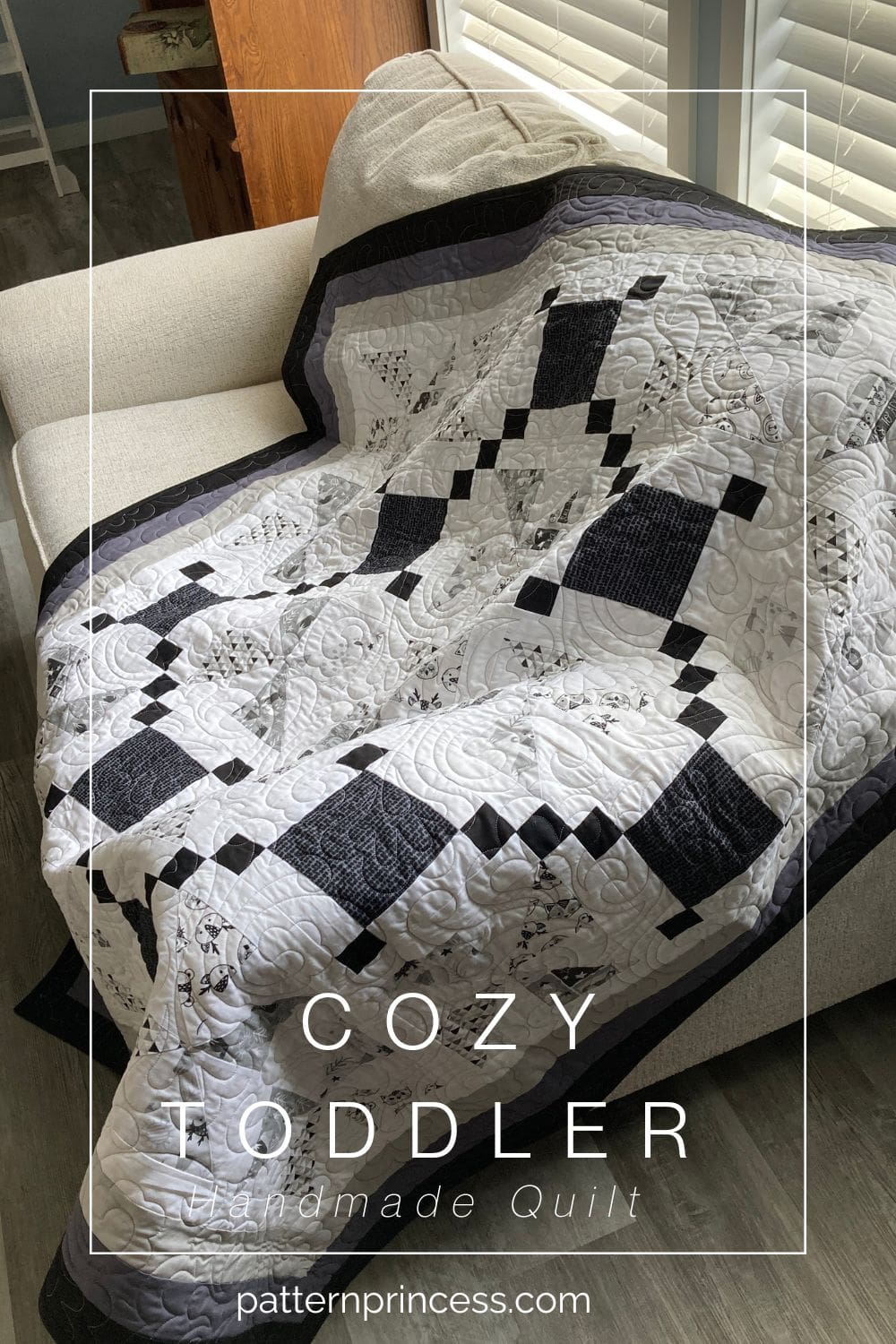
Sewing the Binding to the Quilt Back
You can use your sewing machine to sew the binding on the back of the quilt. However, I often hand-stitch the folded edge onto the back of the quilt.
Once all the sides and corners are stitched, you are done. This beautiful blanket was a fun piece to make.
It is ready to use or it makes the perfect gift for someone special. We hope that you have enjoyed this lovely quilt pattern.

You can find Victoria crocheting, quilting, and creating recipes. She has cooked in restaurants for over 20 years, including many larger parties. She learned to crochet when she was just 11 years old and has been crocheting ever since; over 50 years now. Over 40 years ago, she loved her first class in sewing and continues to hone her skills in quilting. Many have enjoyed the handmade gifts over the years. In her professional career, she has worked in management in a wide variety of businesses including higher education as a dean of a division. All the while attending college part-time to achieve her doctorate in higher education with an emphasis in e-learning.

Incredible! Turned out fabulously!
Oh, gosh, thank you so much. It was a lot of work in such a short amount of time.
Vicky
Nice quilt! Great combination of blocks to make the Irish chain!
Thank you. This one is a nice simple quilt design and I love the results too.
Vicky
Such a fun quilt!
It really is a fun one to make with great results.
Vicky
How sweet! I love the combination of blocks! Thanks for the pattern! xx
Thank you. Enjoy the pattern.
Vicky
Very pretty quilt. I love the neutral colors too.
Thank you so much. I was hoping the neutral colors would help show off the design by the irish chain blocks, yet be a pretty addition themselves.
Vicky
Wow, Great quilt and wonderful instructions. Thank you.
Thank you so much. I really love how this quilt turned out too.
Vicky
Your quilt is wonderful. I love black, white, and grey so this color scheme is perfect. Fits in beautifully.
Thank you so much! I am hoping it will have many years of love.
vicky
Love your quilt. The fabrics are lovely.
Thank you so much. It’s amazing what you can do with a few fat quarter bundles.
Vicky
Great pinwheel / chain quilt!! Perfect for the blog hop! And thanks for sharing the pattern!
Hi Gail,
So glad you enjoyed this one. I just love how it all came together. Enjoy the pattern.
Vicky
Great quilt and a beautiful choice of fabrics.
Thank you for stopping by and taking the time to comment and let me know. I’m very happy with how this one turned out. It inspires me to create more designs.
Vicky
I love the gray and white pinwheels in with the other blocks! Thanks sew much for sharing the pattern!
Thank you Carol,
I must agree, the colors really compliment the design. I think it will work nicely for our toddler to grow up with.
Vicky
Your quilt looks beautiful and your tutorial really shows the way to making it. Thank you for sharing your whirly quilt and instructions! Love it!
Thanks Carol,
I’ve never made a quilt in a week and written the pattern, until now! Next month, I need to start my project earlier. I love how it turned out though.
Vicky
I love the combination of the two different blocks that Irish Chain in the middle really sets it all off. What a fun design for holiday fabrics. Thanks for the sharing the pattern with us.
Thank you Joan. This one turned out so lovely. Enjoy the pattern.
Vicky